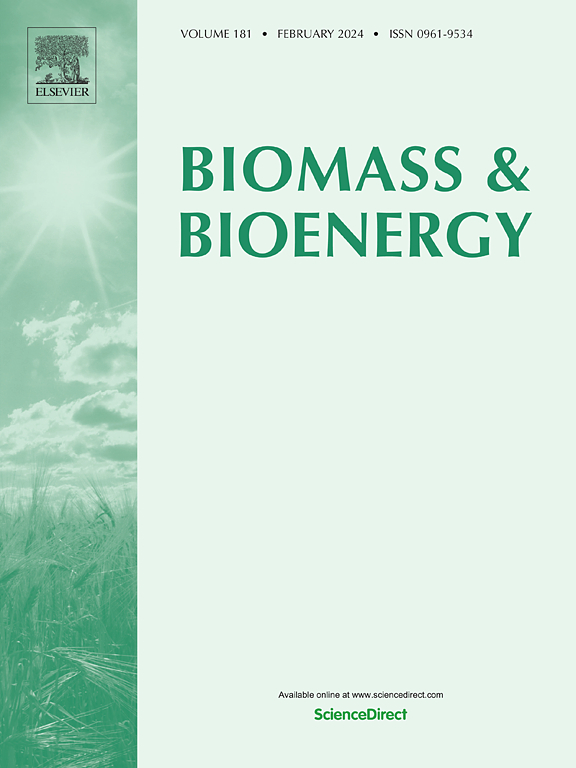高溶解氧条件下xylA分泌表达对提高酿酒酵母木糖发酵效率的影响
IF 5.8
2区 生物学
Q1 AGRICULTURAL ENGINEERING
引用次数: 0
摘要
木糖异构化制备木糖被认为是最有前途的木糖利用方法。Orpinomyces sp. ukk1木糖异构酶(xylA)基因在酿酒酵母(Saccharomyces cerevisiae) INVSc-xylA和INVSc-SS-xylA中分别在细胞内和细胞外表达,以促进生物乙醇的合成,而生物乙醇通常被用作传统化石燃料的替代品。此外,将里氏木霉木糖转运基因Xltr1p与胞内表达的xylA共表达为INVSc-xylA-Xltr1p,进一步提高葡萄糖和木糖共发酵过程中木糖的利用率。混合糖中,INVSc-SS-xylA对木糖的消耗为8.30 g/L,分别比INVSc-xylA和INVSc-xylA- xltr1p高约3倍和2倍。结果表明,在吸收木糖之前将木糖转化为木糖对酿酒酵母的木糖消耗更为有效。此外,高溶解氧(DO)促进了木糖的利用,无论xylA是在细胞外还是细胞内表达。INVSc-SS-xylA的木糖消耗率比INVSc-xylA-Xltr1p高1.5倍。不同DO水平下的INVSc-SS-xylA转录组分析显示,967个差异表达基因(deg)上调,796个差异表达基因(deg)下调。大部分上调的deg与TCA循环、氨基酸代谢和能量代谢等有关。INVSc-SS-xylA使预处理蔗渣水解物的糖制乙醇产量达到0.25 g/g,无需解毒或洗涤预处理生物质。这些结果表明,在混合糖生产高DO乙醇的过程中,细胞外表达的xylA可以改善木糖代谢,并为利用未解毒生物质生产工业乙醇提供有用的方法指导。本文章由计算机程序翻译,如有差异,请以英文原文为准。

Secretory expression of xylA under high dissolved oxygen to improve the xylose fermentation efficiency of Saccharomyces cerevisiae
The isomerization of xylose to xylulose is considered the most promising method for xylose utilization. The xylose isomerase (XI) gene xylA from Orpinomyces sp. ukk1 was expressed intracellularly and extracellularly in modified Saccharomyces cerevisiae strains INVSc-xylA and INVSc-SS-xylA, respectively, to enhance the synthesis of bioethanol, which is frequently utilized as a substitute for conventional fossil fuels. Moreover, the xylose transporter gene Xltr1p from Trichoderma reesei was co-expressed with xylA expressed intracellularly for INVSc-xylA-Xltr1p to further improve xylose utilization in glucose and xylose co-fermentation. INVSc-SS-xylA in mixed sugars consumed 8.30 g/L xylose, which was approximately 3- and 2-fold higher than these of INVSc-xylA and INVSc-xylA-Xltr1p, respectively. This result indicated converting xylose to xylulose prior to absorption was more effective for xylose consumption of S. cerevisiae. Furthermore, high dissolved oxygen (DO) promoted xylose utilization, regardless xylA was expressed extracellularly or intracellularly. INVSc-SS-xylA had a 1.5-fold higher xylose consumption rate than INVSc-xylA-Xltr1p. Transcriptome analysis of INVSc-SS-xylA under different DO levels indicated 967 differentially expressed genes (DEGs) were upregulated and 796 DEGs were downregulated. Most upregulated DEGs were related to TCA cycle, amino acid metabolism and energy metabolism, etc. INVSc-SS-xylA contributed to sugar-to-ethanol yield reached 0.25 g/g from pretreated bagasse hydrolysates, without detoxifying or washing pretreated biomass. These results demonstrated xylose metabolism can be improved by xylA expressed extracellularly in high DO production of ethanol from mixed sugars and provide useful methodological guidance in industrial ethanol production using undetoxified biomass.
求助全文
通过发布文献求助,成功后即可免费获取论文全文。
去求助
来源期刊

Biomass & Bioenergy
工程技术-能源与燃料
CiteScore
11.50
自引率
3.30%
发文量
258
审稿时长
60 days
期刊介绍:
Biomass & Bioenergy is an international journal publishing original research papers and short communications, review articles and case studies on biological resources, chemical and biological processes, and biomass products for new renewable sources of energy and materials.
The scope of the journal extends to the environmental, management and economic aspects of biomass and bioenergy.
Key areas covered by the journal:
• Biomass: sources, energy crop production processes, genetic improvements, composition. Please note that research on these biomass subjects must be linked directly to bioenergy generation.
• Biological Residues: residues/rests from agricultural production, forestry and plantations (palm, sugar etc), processing industries, and municipal sources (MSW). Papers on the use of biomass residues through innovative processes/technological novelty and/or consideration of feedstock/system sustainability (or unsustainability) are welcomed. However waste treatment processes and pollution control or mitigation which are only tangentially related to bioenergy are not in the scope of the journal, as they are more suited to publications in the environmental arena. Papers that describe conventional waste streams (ie well described in existing literature) that do not empirically address ''new'' added value from the process are not suitable for submission to the journal.
• Bioenergy Processes: fermentations, thermochemical conversions, liquid and gaseous fuels, and petrochemical substitutes
• Bioenergy Utilization: direct combustion, gasification, electricity production, chemical processes, and by-product remediation
• Biomass and the Environment: carbon cycle, the net energy efficiency of bioenergy systems, assessment of sustainability, and biodiversity issues.
 求助内容:
求助内容: 应助结果提醒方式:
应助结果提醒方式:


